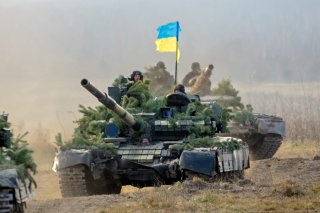Why Ukraine’s Breakthrough Operations Are So Difficult
When analyzing the Ukraine War, it is important to remember that strategically decisive breakthroughs are both difficult to manage and historically rare.
Ukrainian engineers use mine-clearing line charges and robotic technology when these assets are available. If they are in short supply, then Bangalore torpedoes and other explosive devices are used to conserve time and avoid the deadly task of probing for mines with bayonets.
Finally, engineers are racing against the clock as the element of surprise is lost once clearing operations begin—ceding time and tempo to Russian defenders—and lengthening the duration Ukraine must sustain its’ suppressive fires.
Penetrate and Exploit the Breakthrough
The assault element (usually infantry) from the larger breakthrough force must rapidly penetrate the opening engineers have created and attack Russian defenders in trenches on the flanks of the penetration point. Once these trenches are cleared, the assault element must hold this ground—the shoulders of the gap—long enough for an exploitation element (normally mechanized infantry and armor) to pass through and conduct hasty attacks on enemy forces being re-positioned to help blunt the penetration. These attacks are treated as expedient meeting engagements as the exploitation element must avoid becoming decisively engaged while pressing forward to seize key defensible terrain deeper inside Russian-held territory.
Consolidate the Defense and Repeat
Once the breakthrough force reaches its advance limit, it must harden its defensive position, site its heavy weapons to support adjacent Ukrainian defensive positions, and prepare for Russian counterattacks. Additional engineers, artillery, and critical supplies must be poised to push forward to these enclaves to reconstitute Ukrainian forces further to repeat the cycle.
Adapting in War
Ukrainian forces have demonstrated a high capacity to learn from prior tactical engagements and adapt their operations to meet emerging realities on the ground. As General Zaluzhny reported to The Economist, he does not expect robust deliveries of advanced technology to arrive from the West and produce victory. So, limited Ukrainian manpower and legacy machines must be skillfully integrated into tactical approaches, enabling his forces to stay on the tactical offense to recover Ukraine’s lost territory. These operations will be inherently slow and require exquisite synchronization to succeed. As the General noted, they will be neither “deep [n]or beautiful.” However, they are more likely to achieve the war aims Ukraine and the West seek than any other approach.
About the Author
Thomas C. Greenwood, Colonel USMC (Ret.), is a research staff member at the Institute for Defense Analyses. He was an infantryman with subsequent assignments in the Pentagon and the National Security Council staff.

